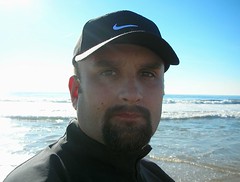Idyllwild Town Crier Said...

Crew building handicapped-accessible trail on Hill
By Halie Johnson
Correspondent
Idyllwild Town Crier
By Halie Johnson
Correspondent
Idyllwild Town Crier
the Stone Creek Campground.
This crew of about seven men and one woman are spending this winter sleeping in tents, hauling and splitting rocks, and clearing foliage for a trail.
Their task is to carve out a wheelchair-accessible loop trail with an offshoot trail to a vista point northwest of the campground. The trail covers about .65 miles. They are the North Coast District¹s Roads, Trails and Resources (RTR) crew, a prototype section of the California State Park based in Humboldt.
The Department of Parks and Recreation is using RTR crews to built wheelchair-accessible trails throughout California.
In 2001, the department released the "Trail Plan For Accessibility in California State Parks." It was prepared by the Accessibility Section Acquisition and Development Division and was updated in December 2003.
"This plan serves as an evaluation of the department¹s pedestrian and multi-use trails, focused on improving opportunities for visitors with disabilities. It outlines the steps relative to trails that the department has taken and will take in order to comply with the Americans with Disabilities Act of 1990," is stated in the introduction to the plan.
"They are pushing for a wheelchair-accessible trail in every park," said Yoni Rivas, the crew supervisor, who has been working with RTR since 1992. In November, crew members arrived on the Hill to begin this project. They estimate they will be working on the trail until February.
Each crew member sleeps in his or her own tent. Their communal camp is equipped with a kitchen tent, a dining tent and a storage tent.
Sarraseca and Luduena prepare the crew¹s breakfasts and dinners, striving for a variety in cuisine.
"Since we are away from home, we try to make it as cozy as possible," Luduena said of the camp. He and Sarraseca met several years ago in L.A., and when Sarraseca¹s wife¹s friend, Liz Martinez, who works with RTR, informed them of the job openings, they both applied.
Sarraseca keeps a blog journaling his experience on the Hill. He writes in Spanish about the meals they¹ve prepared. Sarraseca said that many Argentineans worldwide read his entries. On one occasion, Sarraseca used his grandmother¹s paella recipe, a very traditional paella, but wrote how the ingredients had to come from many
places: the oysters from Thailand, the shrimp from Mexico, additional seafood from Canada, and rice from the Far East. "The only difference," he wrote, "was using saffron instead of turmeric," which meant the paella was its characteristic yellow.
This crew happens to be predominantly bilingual Spanish-English. "We¹re usually the minority," Rivas said. "This time we¹re the majority." According to the Department of Parks and Recreation's plan, the RTR is "the largest and most advanced trail design and construction program in the western United States." RTR has worked with Whole Access and Humboldt Access, two disabilities advocacy organizations, to develop generic guidelines for accessible trails ³without compromising the natural and cultural resources, according to the plan.
Thank you very much to:
Becky Clark Publisher-Editor
Idyllwild Town Crier credit


0 Comments:
Post a Comment
<< Home